Samsung Galaxy Z Fold 2 vs. Galaxy Fold: What’s different?
Samsung is back with another big foldable. The new $1,999 Galaxy Z Fold 2 replaces the original $1,980 Galaxy Fold, and offers a number of noteworthy improvements, from a much larger external display to a more durable hinge, 5G and a more powerful chipset.
The Galaxy Z Fold 2 is also more versatile than its predecessor, thanks to a new Flex Mode and improved multitasking for running three apps on the screen at once. From the specs and design to the features and software, our Galaxy Z Fold 2 vs. Galaxy Fold comparison will spell out all the biggest differences between these two expensive, futuristic devices.
Samsung Galaxy Z Fold 2 vs. Galaxy Fold: Design and displays
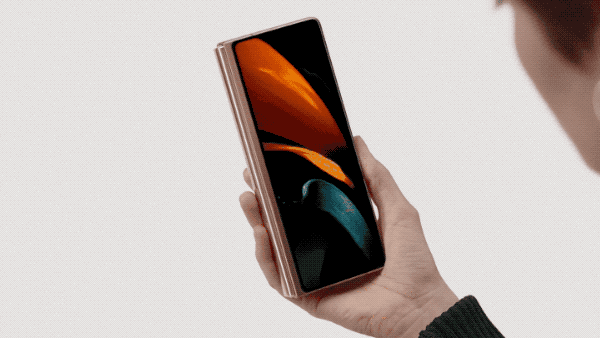
While both the Galaxy Z Fold 2 and Galaxy Fold feature a pair of displays inside and out, the newer device’s screens are better in just about every sense.
The original Fold incorporated a tiny 4.6-inch AMOLED panel on the outside, along with a 7.3-inch AMOLED one on the inside protected by a plastic substrate. The new model swaps out the external one with a new 6.2-inch display, and bumps the size of the primary screen to 7.6 inches.
The 7.6-inch panel also sees an improved 120Hz refresh rate, carrying over the dynamic LTPO technology introduced in the Galaxy Note 20 Ultra, which allows it to match its speed to the frame rate of whatever content is currently playing.
The use of ultra-thin glass will undoubtedly make the big screen on the Z Fold 2 more durable and nicer to look at than the original Galaxy Fold’s, which suffered from strange depressions and an orange peel effect under certain light. The Z Fold 2’s hinge is stronger as well, owing to Samsung’s new Sweeper system, which uses bristles to effectively move dust and debris away from behind the screen, where it could damage things. This was an issue for some early first-gen Galaxy Fold reviewers, so we’re glad to see it addressed here.
The Galaxy Z Fold 2 is slightly shorter yet wider than its predecessor, and weighs in at 9.9 ounces, which is half an ounce more than the original model. A new cam mechanism allows the Z Fold 2’s screen to stay partially folded in a number of positions between shut or fully open, and when the device is closed, the gap in between the two halves is slimmer. The first Galaxy Fold couldn’t stay partially open — it was either open all the way, or not at all.
The Galaxy Z Fold 2 comes in two colors: Mystic Bronze and Mystic Black. The original Galaxy Fold was offered in Space Silver, Cosmos Black, Martian Green and Astro Blue.
Samsung Galaxy Z Fold 2 vs. Galaxy Fold: Specs
| Samsung Galaxy Z Fold 2 | Samsung Galaxy Fold | |
|---|---|---|
| Starting price | $1,999 | $1,980 |
| Display | 7.6-inch interior OLED (120Hz); 6.2-inch exterior OLED | 7.3-inch interior OLED (60Hz); 4.6-inch exterior OLED |
| Processor | Snapdragon 865 Plus | Snapdragon 855 Plus |
| RAM | 12GB | 12GB |
| Storage | 256GB | 512GB |
| Rear cameras | 12MP wide, 12MP ultrawide, 12MP telephoto (2x optical, 10x digital zoom) | 12MP wide, 16MP ultrawide, 12MP telephoto (2x optical, 10x digital zoom) |
| Front camera | 10MP (both displays) | 10MP exterior, 10MP and 8MP depth interior |
| Battery size | 4,500 mAh | 4,380 mAh |
| Battery life (Hrs:Mins) | Not yet tested | 10:01 |
| Size | 6.2 x 2.6 x 0.66 inches (closed); 6.2 x 5 x 0.27 inches (open) | 6.3 x 2.5 x 0.66 inches (closed); 6.3 x 4.6 x 0.27 inches (open) |
| Weight | 9.9 ounces | 9.3 ounces |
Samsung Galaxy Z Fold 2 vs. Galaxy Fold: Cameras
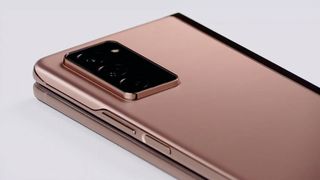
Triple-lens rear camera systems can be found on both the Galaxy Z Fold as well as the Galaxy Fold, and if you’re looking closely at the spec sheet, it’ll seem as though not much has changed. Both devices have 12-megapixel primary and 2x optical zoom telephoto lenses, with slight differences in aperture, as Samsung has ditched its old variable aperture system in its latest models. Meanwhile, the old 16-MP ultrawide shooter has been scrapped in favor of a 12-MP unit.
As for front facing cameras, there are two 10MP lenses on the Galaxy Z Fold 2, above the exterior and interior displays. The first Fold had an extra, front-facing 8MP depth sensor inside, though that hasn’t made the jump to the newer model. Nevertheless, the Z Fold 2 can still capture Live Focus selfies, even without the help of that extra sensor.
Samsung’s mobile imaging hardware is getting awfully good — the Note 20 Ultra has a phenomenal set of cameras, between its 108-MP main sensor and 5x optical zoom, while the regular Note 20 (which I’ve personally been using lately) has a solid stack of optics as well that can rival (and in many cases, exceed) Apple’s best efforts in the iPhone 11 Pro Max. Therefore, we expect the new Fold’s cameras to be even better than the ones they’re replacing, despite how similar the hardware may look from the outside.
In addition, the Galaxy Z Fold 2 has a couple of new camera tricks. Auto framing keeps subjects in the frame when you’re shooting video. This comes in handy if you have the Z Fold 2 in its laptop-like Flex Mode. You can also use the rear cameras for selfies and the front camera as a viewfinder; or you can let subjects see themselves through the cover display as you’re taking shots, ensuring nobody will ever ask you for retakes (maybe).
Samsung Galaxy Z Fold 2 vs. Galaxy Fold: Performance
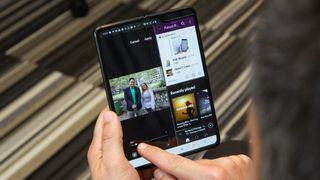
Like the Galaxy Note 20 range, the Galaxy Z Fold 2 utilizes Qualcomm’s latest and greatest Snapdragon 865 Plus processor, alongside 12GB of RAM. There is only 256GB of non-expandable onboard storage in the Z Fold 2, and there isn’t a 512GB option this time around — meaning you’ll have to make the best of what the device comes with.
The original Galaxy Fold, having released last year, features the Snapdragon 855 chipset as well as 12GB of RAM. However, it came with 512GB storage standard — one of the first-gen model’s only obvious advantages over the follow up.
The 865 Plus represents a marked improvement over the 855. Consider that the Galaxy Fold scored 2,619 points in the system-wide, multi-core Geekbench 5 test we conducted last year, whereas the new Galaxy Z Fold 2 hit 3,193. The newer foldable is certainly going to be more adept at multitasking and juggling background processes, which is exactly what you want from a multifaceted, foldable tablet/phone hybrid like these devices are.
Samsung Galaxy Z Fold 2 vs. Galaxy Fold: Software
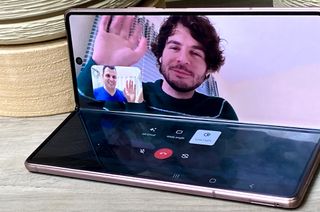
Samsung introduced a number of helpful user interface features and tweaks in the original Galaxy Fold and Galaxy Z Flip that have been tweaked and improved for the Galaxy Z Fold 2.
One of them is Flex Mode. Together with the Z Fold 2’s new cam hinge, the device can unfold to several angles and stay put. When in this orientation, the phone will show different content on the top of the display relative to the bottom, to offer expanded controls for certain apps. Google Duo is one such app, as is YouTube and most of Samsung’s first-party software, including the gallery and camera. Samsung says it is working with third-party developers to help create even more apps optimized for Flex Mode.
App Continuity also allows you to get a closer look at content displayed on the external screen, simply by opening the device. For example, if you’re watching a YouTube video while the phone is folded and then you open it up, the video will instantly resume on the interior screen where it left off.
Samsung has also improved the Galaxy Z Fold 2’s Multi-Active Window feature, so that it can be used to launch three apps in tandem. Images and text can be dragged between windows as well, which is sure to excite those buying the Z Fold 2 for its productivity potential.
While Samsung may bring some newer software enhancements to the original Galaxy Fold over time, that device is physically incapable of accommodating Flex Mode, because it lacks the cam mechanism that allows the Z Fold 2’s hinge to stop in place. That arguably makes it less compelling for power users, and provides another reason to spring for the new model.
Samsung Galaxy Z Fold 2 vs. Galaxy Fold: Battery and charging
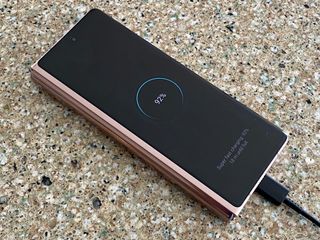
The Galaxy Z Fold 2 features a 4,500-mAh battery, a slight step up from the 4,380-mAh power pack in the first Fold. The new phone ships with a 25-watt charging adapter and once again supports wireless charging and reverse PowerShare charging for accessories, which is very convenient and impressive given how much Samsung has packed into this device.
Samsung Galaxy Z Fold 2 vs. Galaxy Fold: Outlook
Samsung’s first stab at a foldable phone was ambitious, but clearly fraught with teething problems. The Galaxy Z Fold 2 addresses practically every fault someone might’ve had with its predecessor (save for the high price tag, of course).
We’re in the process of testing and reviewing our Galaxy Z Fold 2, so we can’t recommend the device yet. However, if you’ve been waiting for a second-generation foldable to smooth out the kinks of those early attempts, the Galaxy Z Fold 2 is progressively looking more and more like it could be that device, and a far smarter buy than its predecessor. And for $2,000, it better be.

